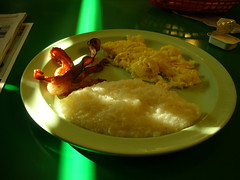Yet it seems that every bowl that a grit occupies is a grits bowl, in complete harmony with itself. The zen of grits. A universal truth.
Bunny
This was the concluding statement in an e-mail discussion amongst a group of potters. One had posed the question, “Why are there no bowls made specifically for grits?” In previous posts I’ve stated my convictions. Here’s an alternate theory…
I will stand corrected by those who know more about it, but presumably because unlike rice, soup, cereal, etc. grits are never served on their own, but with something else? Whether bacon and eggs or cabbage and bacon to at least give them some sort of taste? They must surely be the blandest form of carbohydrate filler ever invented by man!…Even porridge tastes stronger in comparison… Porridge or more correctly gruel is called Haferschleim or “oat slime” in Germany and grits would probably get the same lingual treatment!
Janet Kaiser
I must disagree. It’s not that grits need something else as accompaniment, but that it is an integral part of the meal, and not to be separated from the rest of the breakfast as an option.
 So here I present my further observations about the nature of grits…
So here I present my further observations about the nature of grits…
- There is no singular form for grits. Grits is always referenced as a collective. Therefore, “Grits is” is proper grammar.
- As mentioned before, grits should be served right on the plate, and not in a separate dish.
- The proper utensil for eating grits is always a fork – never a spoon. Things served in bowls are eaten with a spoon, and since grits is served on a plate, a fork should be used. This should be the case regardless of the texture of the grits.
- The only exception to number 2 above is when grits is served on its own, perhaps mixed with cheese or bacon bits. Regardless, number 3 still comes into play. Grits should still be eaten with a fork.
- Polenta is just high-falutin’ grits.
I’m sure more revelations will come to me as I ponder the zen of grits.
[tags]zen, grits[/tags]